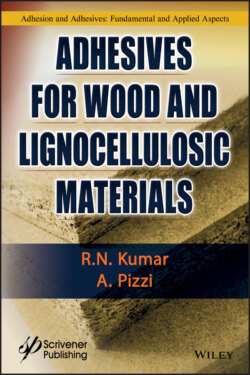Читать книгу Adhesives for Wood and Lignocellulosic Materials - R. N. Kumar - Страница 27
1.4.3.4 Dehydrogenation Polymer (DHP)
ОглавлениеThe biosynthesis of lignin from the monomeric phenylpropane units can be generally described as a dehydrogenative polymerization. The principal ideas about such a pathway were elaborated by Freudenberg and co-workers [11]. They were the first to produce in vitro lignin called dehydrogenation polymer (DHP) by treating coniferyl alcohol with a fungal laccase from the mushroom Psalliota campestris or with a horseradish peroxidase by hydrogen peroxide.
The first step of the biochemical pathway for building up lignin macromolecules is the enzymatic dehydrogenation of p-hydroxycinnamyalcohols, yielding mesomeric ring systems with a loosened proton. Figure 1.7 shows the formation of phenoxy radicals from coniferyl alcohol by a one-electron transfer:
Figure 1.7 Enzymatic dehydrogenation of coniferyl alcohol yielding phenoxy radicals.
The origin of the hydrogen peroxide was cleared up by discovering cell-wall-bound enzyme systems able to deliver H2O2 [22, 23].
Only 4-phenoxyradical I to IV are actually involved in lignin biosynthesis. Structure V is sterically hindered or thermodynamically not favored [24].
The polymerization of monomeric precursors by random coupling reactions cannot be studied in vivo, but it is known from numerous in vitro experiments to run without enzymatic control as a spontaneous process. The first step in polymerization is the formation of dimeric structures. Some prominent lignol dimers called dilignols are shown in Figure 1.8.
Figure 1.8 Typical dilignol structures [25].
Further polymerization is called end-wise polymerization involving coupling of monolignols with the phenolic end groups of di- or oligolignols or a coupling of two end group free radicals, yielding a branched polymer via tri-, tetra-, penta-, and oligolignols [11].
Summarizing the formation of lignin, as mentioned by Fengel and Wegener [11], it is evident that these macromolecules are not formed by a genetically prescribed regular mechanism, but by a random coupling of lignols to form a nonlinear polymer. The final constitution of lignin is therefore determined mostly by reactivity and the frequency of the building units involved in its polymerization.
Proportions of different types of linkages connecting the phenylpropane units in lignin are given in Table 1.1.
Table 1.1 Proportions of different types of linkages connecting the phenylpropane units in lignin.
| Percent of the total linkages | |||
| Linkage typeb | Dimer structure | Softwooda | Hardwooda |
| β-O-4 | Arylglycerol-β-aryl ether | 50 | 60d |
| α-O-4 | Noncyclic benzyl aryl ether | 2–8c | 7 |
| β-5 | Phenylcoumaran | 9–12 | 6 |
| 5–5 | Biphenyl | 10–11 | 5 |
| 4–0–5 | Diaryl ether | 4 | 7 |
| β-1 | 1,2-Diaryl propane | 7 | 7 |
| β-β | Linked through side chains | 2 | 3 |
a Approximate values based on data of Adler [26] obtained for MWL from spruce (Picea abies) and birch (Betula verrucosa).
b For corresponding structures.
c Values have been reported [25].
d Of these structures, about 40% are of guaiacyl type and 60% are of syringyl type.
